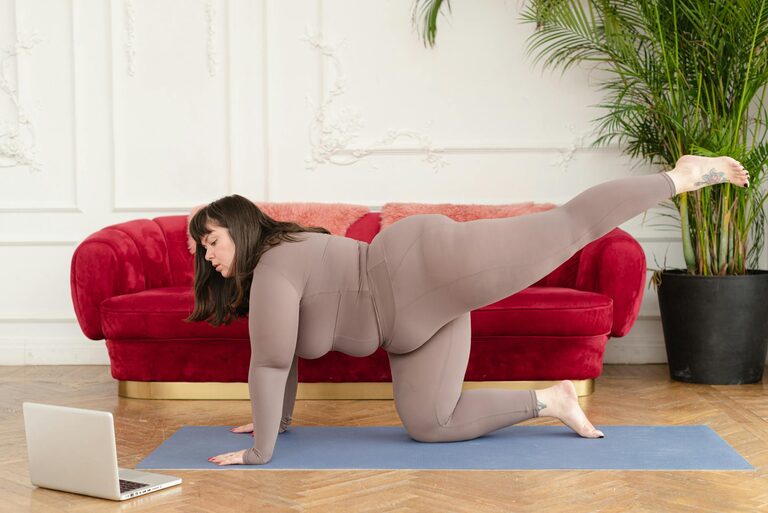Stretching is a simple, accessible way to enhance your physical health and overall wellbeing. Whether you’re new to fitness or looking to add a gentle activity to your routine, stretching at home requires no special equipment and can fit easily into your day. In this beginner’s guide, we’ll explore why stretching matters, how to get started, and simple routines you can try right away.
Why Stretching Matters
Stretching helps improve flexibility, which is your body’s ability to move joints through a full range of motion. Greater flexibility can improve posture, reduce the risk of injuries, and decrease muscle soreness and tension. Additionally, stretching promotes blood flow and relaxation, making it a great method to unwind after a long day.
Getting Started: Tips for Safe Stretching
Before you begin, keep these important points in mind to stretch safely:
– Warm Up First: Stretching cold muscles can lead to injury. Spend 5 minutes warming up with light activity like walking or marching in place.
– Move Slowly: Avoid bouncing or jerking motions. Stretch gently and hold steady positions.
– Breathe Deeply: Maintain relaxed, steady breathing during stretches to increase oxygen flow and reduce tension.
– Know Your Limits: You want a feeling of gentle tension but no pain. Stretch only as far as comfortable.
– Consistency is Key: Stretch regularly—ideally daily or at least 3 times a week—to see improved flexibility over time.
Basic Stretches for Beginners
Here are some easy stretches focusing on commonly tight areas. Hold each stretch for 15–30 seconds and repeat 2–3 times on each side when applicable.
1. Neck Stretch
– Sit or stand tall with your spine straight.
– Gently tilt your head toward your right shoulder until you feel a stretch along the left side of your neck.
– Hold, then switch sides.
– This stretch helps relieve neck tension from desk work or screen time.
2. Shoulder Stretch
– Extend your right arm across your chest.
– Use your left hand to gently press your right arm closer to your chest.
– Hold, then repeat on the other side.
– This stretch targets the shoulders and upper back.
3. Chest Opener
– Clasp your hands behind your back and straighten your arms.
– Gently lift your chest and squeeze your shoulder blades together.
– This stretch opens the chest and counteracts slouching.
4. Cat-Cow Stretch
– Come onto your hands and knees in a tabletop position.
– Arch your back up (Cat), tucking your chin to your chest.
– Then lower your belly toward the floor while lifting your head and tailbone (Cow).
– Repeat slowly for 5–10 breaths.
– This move increases spinal flexibility and soothes back muscles.
5. Seated Hamstring Stretch
– Sit on the floor with your right leg extended.
– Bend your left knee, placing the sole of your foot against your right inner thigh.
– Lean forward from your hips toward your right foot, keeping your back flat.
– Hold, then switch legs.
– Stretching hamstrings can improve lower back health and mobility.
6. Quadriceps Stretch
– Stand with feet hip-width apart.
– Bend your right knee and bring your heel toward your buttocks.
– Hold your ankle with your right hand, keeping knees side by side.
– Hold, then switch sides.
– This stretch targets the front of the thigh and improves knee flexibility.
7. Calf Stretch
– Stand facing a wall, hands placed on the wall at shoulder height.
– Step your right foot back, keeping your heel on the floor and your leg straight.
– Bend your left knee and lean forward slightly until you feel a stretch in your right calf.
– Hold, then switch sides.
– Calf stretches help with ankle mobility and balance.
Creating a Simple Stretching Routine
You can mix and match these stretches depending on your needs and the time you have available. Here’s a sample 10-minute routine:
- Warm-up: March or walk in place for 2 minutes
- Neck stretch: 30 seconds per side
- Shoulder stretch: 30 seconds per side
- Chest opener: 30 seconds
- Cat-Cow: 1 minute
- Seated hamstring stretch: 30 seconds per leg
- Quadriceps stretch: 30 seconds per leg
- Calf stretch: 30 seconds per leg
Repeat this routine 3-4 times per week, or daily for best results.
Additional Tips for Home Stretching Success
– Consistency Over Intensity: Stretch gently and regularly rather than pushing too hard occasionally.
– Use Props: A yoga mat, strap, or towel can assist with some stretches.
– Stay Mindful: Stretching is a great time to focus on your body and breath—consider it a mini mindfulness session.
– Listen to Your Body: If a stretch causes discomfort, ease off or try a gentler variation.
Conclusion
Starting a stretching routine at home is an excellent way to care for your body and mind. With just a few simple moves and a commitment to daily practice, you can enjoy increased flexibility, reduced tension, and a sense of calm. Remember to be patient with yourself—improvements come with time and consistency. Happy stretching!
—
If you found this guide helpful, consider sharing your favorite stretches or tips in the comments below!

